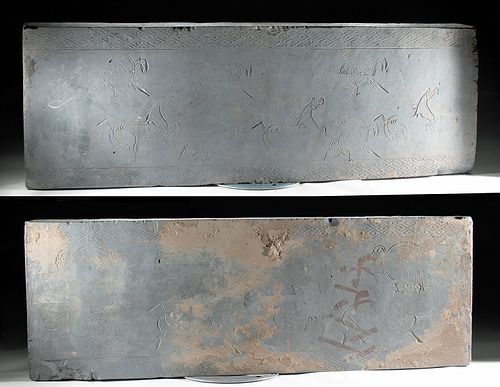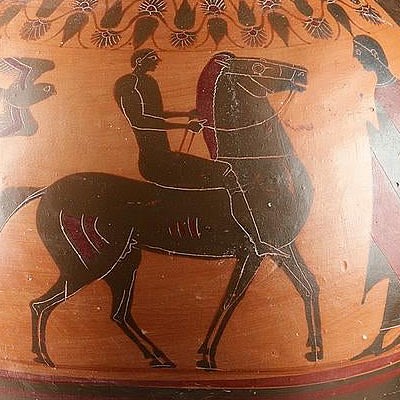Huge Chinese Han Dynasty Clay Tomb Panels, TL Tested
Lot 126
About Seller
Artemis Gallery
686 S Taylor Ave, Ste 106
Louisville, CO 80027
United States
Selling antiquities, ancient and ethnographic art online since 1993, Artemis Gallery specializes in Classical Antiquities (Egyptian, Greek, Roman, Near Eastern), Asian, Pre-Columbian, African / Tribal / Oceanographic art. Our extensive inventory includes pottery, stone, metal, wood, glass and textil...Read more
Categories
Estimate:
$16,000 - $20,000
Absentee vs Live bid
Two ways to bid:
- Leave a max absentee bid and the platform will bid on your behalf up to your maximum bid during the live auction.
- Bid live during the auction and your bids will be submitted real-time to the auctioneer.
Bid Increments
| Price | Bid Increment |
|---|---|
| $0 | $25 |
| $300 | $50 |
| $1,000 | $100 |
| $2,000 | $250 |
| $5,000 | $500 |
| $10,000 | $1,000 |
| $20,000 | $2,500 |
| $50,000 | $5,000 |
| $100,000 | $10,000 |
| $200,000 | $20,000 |
About Auction
By Artemis Gallery
Jun 4, 2020
Set Reminder
2020-06-04 10:00:00
2020-06-04 10:00:00
America/New_York
Bidsquare
Bidsquare : Exceptional Antiquities, Asian, Ethnographic
https://www.bidsquare.com/auctions/artemis-gallery/exceptional-antiquities-asian-ethnographic-5185
An important one-day auction featuring museum-worthy examples of Egyptian, Greek, Roman, Etruscan, Near Eastern, Far East / Asian, Pre-Columbian, African / Tribal, Oceanic, Native American, Spanish Colonial, Russian, Fossils, Ancient Jewelry, Fine Art, so much more! Artemis Gallery info@artemisgallery.com
An important one-day auction featuring museum-worthy examples of Egyptian, Greek, Roman, Etruscan, Near Eastern, Far East / Asian, Pre-Columbian, African / Tribal, Oceanic, Native American, Spanish Colonial, Russian, Fossils, Ancient Jewelry, Fine Art, so much more! Artemis Gallery info@artemisgallery.com
- Lot Description
East Asia, China, Han Dynasty, ca. 206 BCE to 220 CE. An amazing pair of massive, hollow clay bricks from a Han tomb. Before they were fired, artisans stamped these bricks with the artwork you see here: decorative diamond-shaped borders on the long edges and repeated phoenixes and horses. Each phoenix has a long tail and pointed wings that resemble lightning strikes; the bird's crested head is turned back as if looking over its shoulder and it stands on delicate feet. The interior of the birds' bodies feature curved lines that form auspicious shapes. The horses, meanwhile, have rounded bodies with large back haunches, thick necks, and heads proudly raised; they are posed as if prancing, and have bridles to indicate that they belong to someone rather than running free. Size of one (they are nearly identical in size): 5.5" L x 18.2" W x 54.3" H (14 cm x 46.2 cm x 137.9 cm)
These bricks, each over four feet tall, were made to construct the rectangular chambers of a traditional Han tomb, which would have been dug into the ground and divided into different rooms. Doors and a lintel would also have been featured, completing the tomb, which would have contained a coffin atop a stone "couch" and numerous grave goods befitting the status of the person interred.
Both animals stamped on these bricks had deep meaning for the ancient Chinese. In Chinese legend, the phoenix is the most beautiful of all birds, called the feng huang, and the etymology of the name is derived from "emperor"; the bird also symbolizes the south. Meanwhile, Han period horses came from the Ferghama Valley in Central Asia - present day Afghanistan. When elite individuals passed away, large "walking" terracotta Ferghama horses displaying an immense degree of attention to detail were created to carry the deceased into the hereafter. These horses were believed to possess magical powers. The number of horses owned by an individual ensured his high status in the afterlife.
See similar clay bricks from Han tombs at the Chicago Institute of Art (1924.449; 1924.447a-b).
This piece has been tested using thermoluminescence (TL) analysis and has been found to be ancient and of the period stated. A full report will accompany purchase.
Provenance: private Vero Beach, Florida, USA collection, purchased in the 1980s-1990s; ex-old English collection
All items legal to buy/sell under U.S. Statute covering cultural patrimony Code 2600, CHAPTER 14, and are guaranteed to be as described or your money back.
A Certificate of Authenticity will accompany all winning bids.
We ship worldwide and handle all shipping in-house for your convenience.
#152884Both are intact. Small chips, nicks, and scratches - mainly from peripheries - commensurate with age, and a few surface fissures from the firing process/flexing. Deposits in some areas obscure the motifs, which are also worn in places from time. However, most are still clearly visible. Orange writing/markings are on two of the faces, but do not obscure the Han period artwork. Both have tiny TL testing holes drilled into their undersides.Condition
- Shipping Info
-
All shipping is handled in-house for your convenience. Your invoice from Artemis Gallery will include shipping calculation instructions. If in doubt, please inquire BEFORE bidding for estimated shipping costs for individual items.
-
- Buyer's Premium



 EUR
EUR CAD
CAD AUD
AUD GBP
GBP MXN
MXN HKD
HKD CNY
CNY MYR
MYR SEK
SEK SGD
SGD CHF
CHF THB
THB


















